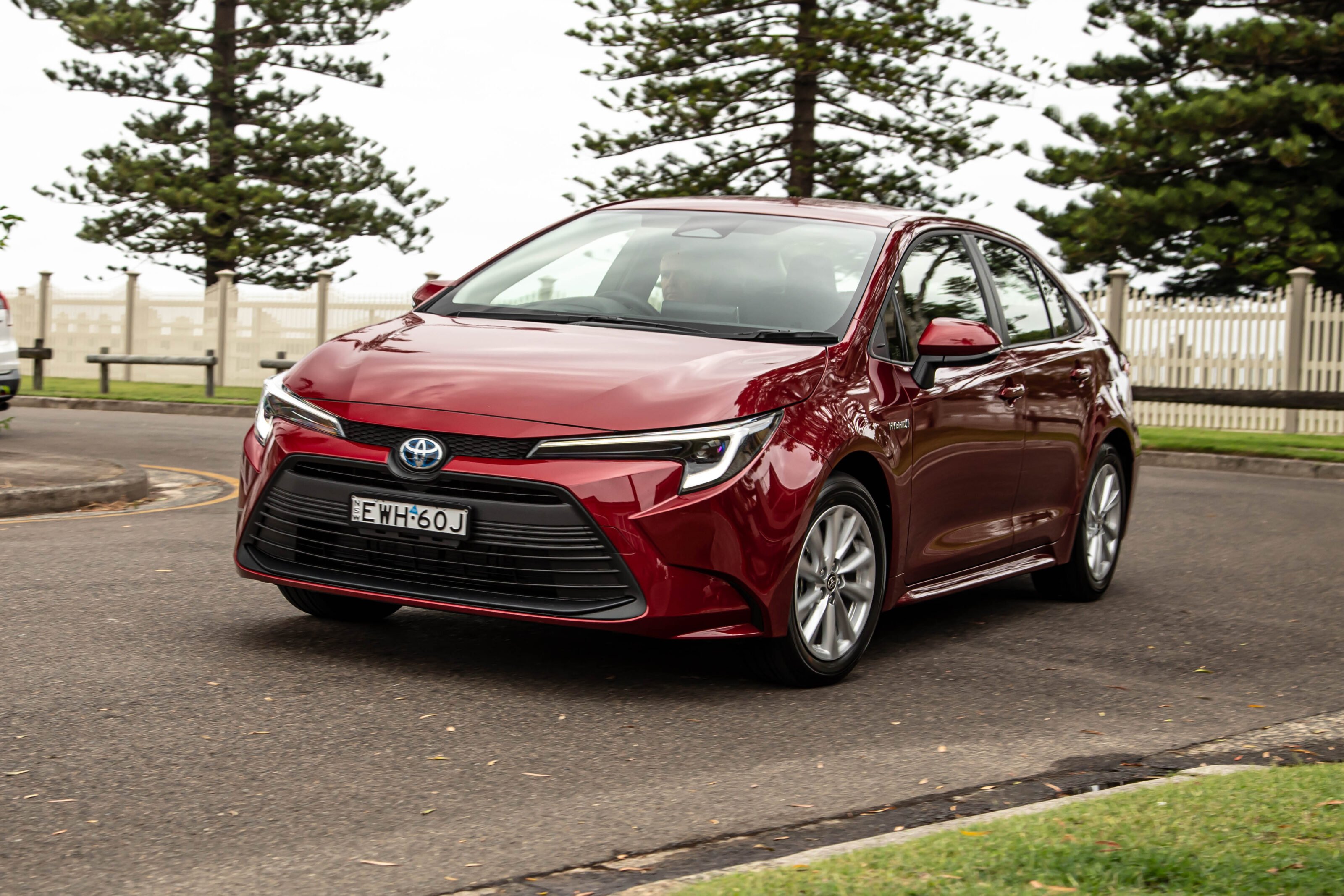Score breakdown
Things we like
- Brilliant fuel economy
- Improved hybrid powertrain
- New screen
Not so much
- Plastic steering wheel
- Cheap tyres
- A bit boring to look at
Few cars are as well-known as the Toyota Corolla.
It’s such a powerful name that when other markets changed its name to Auris – I still cannot work out why that happened – Toyota Australia was having none of it. A generation passed and the nameplate returned the world over.
Despite the path well-trodden by the Prius to get out the word about hybrid, that car has disappeared from our shores because nobody bought it. Why would you when you could buy a Corolla for a lot less money and, perhaps almost as importantly, have fewer people laugh at you in your under-wheeled spaceship.
Toyota could have built an empire on electrification but instead of chucking itself at EVs, has decided to keep sharpening the hybrid saw. A few weeks back I drove the Corolla ZR hybrid hatch and came away even more impressed than I was before. Now it’s the sedan’s turn, but this time in entry-level Ascent Sport form.
RELATED READING
Looking for more details on the wider Corolla range? Our full range review has everything you need to know.
JUMP AHEAD
- How much is it, and what do you get?
- How do rivals compare on value?
- Interior comfort, space and storage
- What is it like to drive?
- How is it on fuel?
- How safe is it?
- Warranty and running costs
- VERDICT
- Specifications
How much is it, and what do you get?
The hybrid Corolla sedan kicks off at a very competitive $31,680 before on-road costs. I don’t think there’s any other hybrid on the market that brings this much space for the money, and it’s a thing that continues to baffle me in such a competitive market.
| 16-inch alloy wheels | Reversing camera |
| Six-speaker stereo | Space-saver spare |
| Climate control | Auto LED headlights with auto high beam |
| Wireless Carplay | Auto wipers |
| Wired Android Auto | Satellite navigation |
| DAB digital radio | Climate control |
| Cloth trim | Active cruise control |
The new media system looks much more modern, with a lighter sat-nav interface. Sadly the same cheap buttons flank the screen.
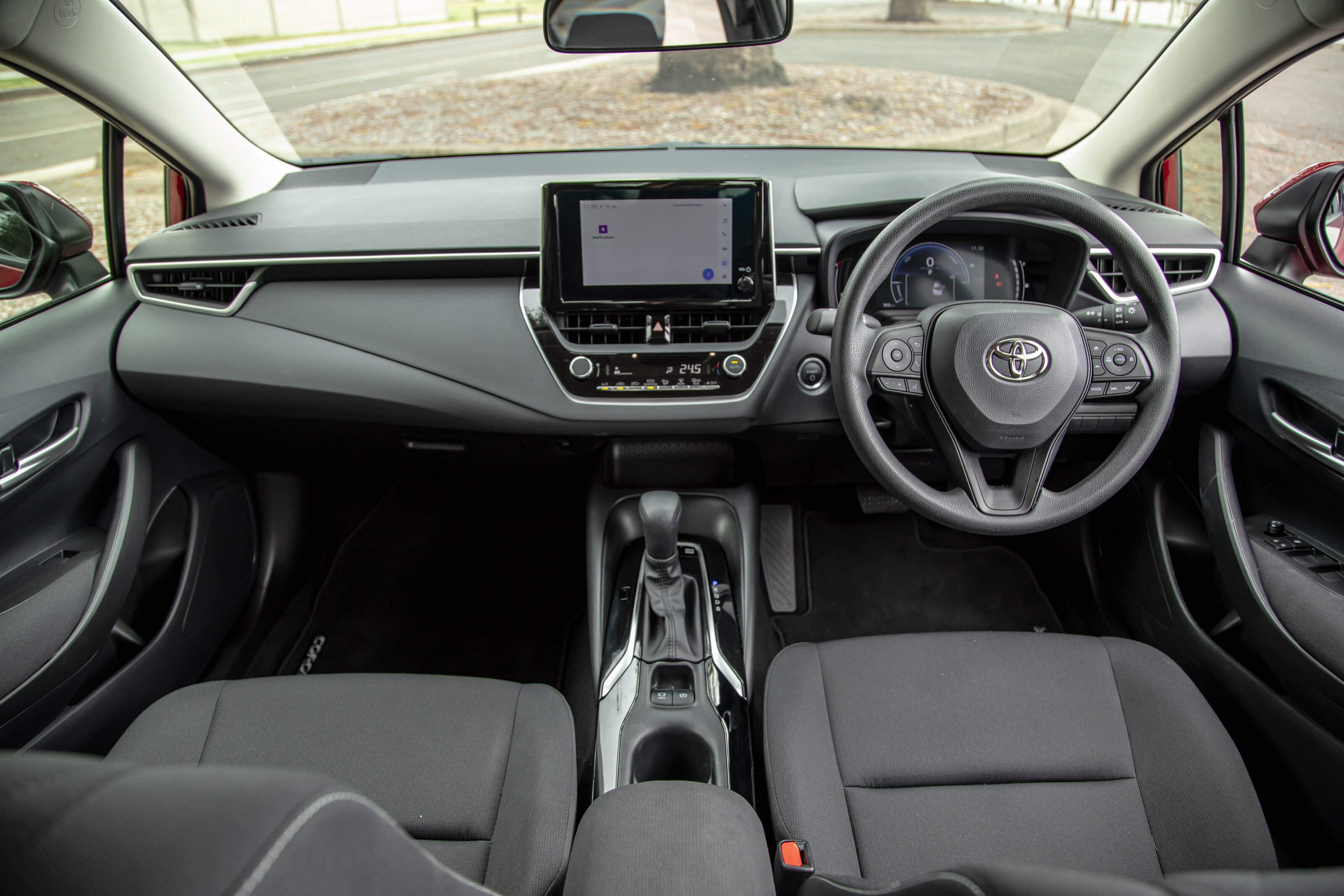
How do rivals compare on value?
A small hybrid sedan from another manufacturer? There isn’t one, and definitely not at this price. The closest thing you can get is the Kia Niro hybrid, but it’s substantially more expensive, and not a sedan.
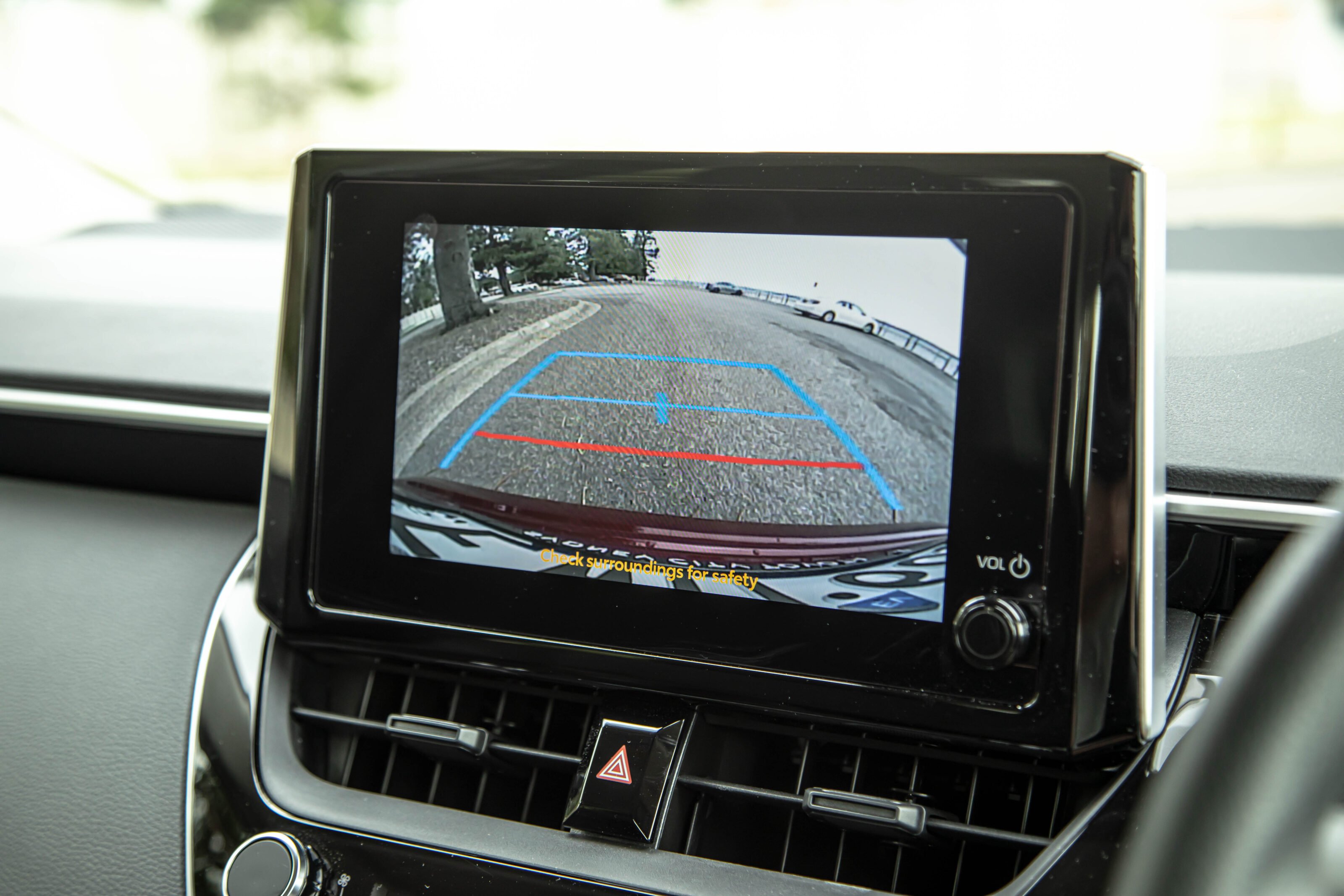
Interior comfort, space and storage
The sedan’s wheelbase is 2700mm, just 40mm longer than the hatch’s. The Hyundai i30 sedan rides on a longer wheelbase and the Kia Cerato sedan and hatch ride on identical but longer wheelbases but seem to make more of it. The length seems all about the boot.
Behind a nice wide-opening boot aperture is 470 litres of cargo space, much bigger than that of the Corolla hatch. If you need a hybrid that can carry things, this is the Corolla for you. The boot in the sedan is also more usable than that of the, with a more regular shape. Toyota doesn’t offer a seats-down capacity figure.
Compared to the Corolla hatch, things still aren’t exactly roomy in the sedan’s back seat, with tight legroom but improved headroom. You have pockets in the doors – which are larger than those of the hatch – and the cup holders move to the centre armrest.

The rear seat itself is comfortable enough and a middle passenger won’t be so uncomfortable that a short trip will cause problems.
In the front, you’re treated to the excellent front seats from the hatch. I’ve said it before; I feel like someone from Toyota rode in the front of a Peugeot and said, “Hey, they’re really nice, we should do that!” They look good and apart from being a little soft with the cloth trim, are quite supportive.
The narrow centre console houses two cup holders, a couple of switches and the gear selector. Ahead of these is a space for your phone and the USB-C port.

I can’t say I’m a fan of the plastic steering wheel and genuinely wonder if they’re that much cheaper than something wrapped in a nicer covering. It just feels really cheap and even the base model Kia Seltos doesn’t have one anymore.
The new touchscreen is so much nicer to use than the old one and has wireless Apple CarPlay and wired Android Auto. Much nicer hardware and software bring this car into the 2020s although it still takes a little getting used to.
Climate control switchgear is still a naff line of chrome buttons that look really cheap, along with some of the low-grade plastics in the cabin. It is, however, pretty hardy looking and feeling in here, with the vibe of a fleet special.
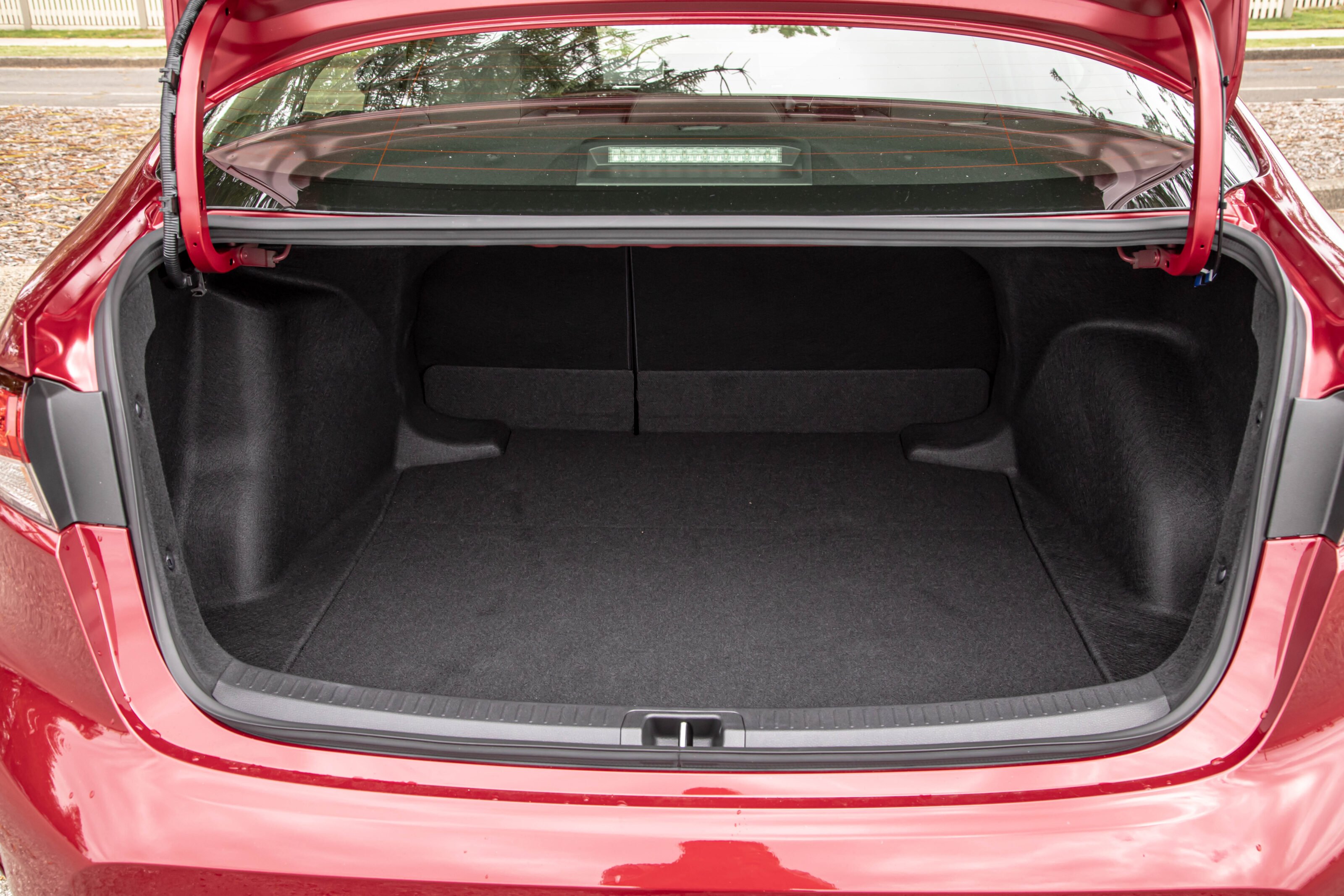
What is it like to drive?
The last time I drove a Corolla hybrid sedan I was disappointed. It was really quite slow, although very smooth and didn’t use much fuel. The lack of pace was disappointing and meant I had to work it hard to get it moving.
Luckily, Toyota’s mid-2022 Corolla refresh sorted that right out. For MY23, Toyota has fitted an updated electric motor, smaller hybrid componentry and switched to a lithium-ion battery pack from the ancient Ni-Mh unit.
The whole system is lighter and power increases by 13kW. I can’t help feeling that more torque reaches the front wheels, but Toyota won’t say what the combined torque figure is.

| 2023 Toyota Corolla Ascent Sport hybrid sedan drivetrain | |
|---|---|
| Drive | front-wheel |
| Engine | 1.8-litre four-cylinder hybrid |
| Transmission | continuously variable |
| Power (ICE) | 72kW @ 5200rpm |
| Torque (ICE) | 142Nm @ 3600rpm |
| Power (EV) | 70kW |
| Torque (EV) | 185Nm |
| Combined power | 103kW |
| Combined torque | not specified |
Toyota cheekily calls this a self-charging hybrid when in fact it’s exactly the same hybrid concept it has had on the market for two decades. The 1.8-litre petrol engine turns the front wheels via a continuously variable automatic transmission, with an electric motor buried in there to deploy on acceleration and harvest energy from braking.
It now feels far peppier due to the extra power of this new hybrid set-up, which is quite handy and sufficiently gruntier that the front wheels cheerfully chirp. Although that could be down to the very cheap tyres fitted by Toyota to help keep costs down. They’re fine, I guess, but if they can’t handle the torque of the engine in the dry, perhaps a slightly better set might be in order.

Ride and handling aren’t as sparkly as the hatch, with a bit of extra weight and length and, I assume, a more conservative suspension tune. The result is a little more roll than the hatch, but nothing to upset stomachs or take away from the fairly serene driving experience.
Disappointment with the old car’s slowness has been replaced with a new-found fondness for the way it goes about its business. It’s not going to win any races but it’s more relaxed for someone like me knowing it’s got a bit more go.
It’s quite a nice car to drive around in even if it doesn’t look particularly cool.
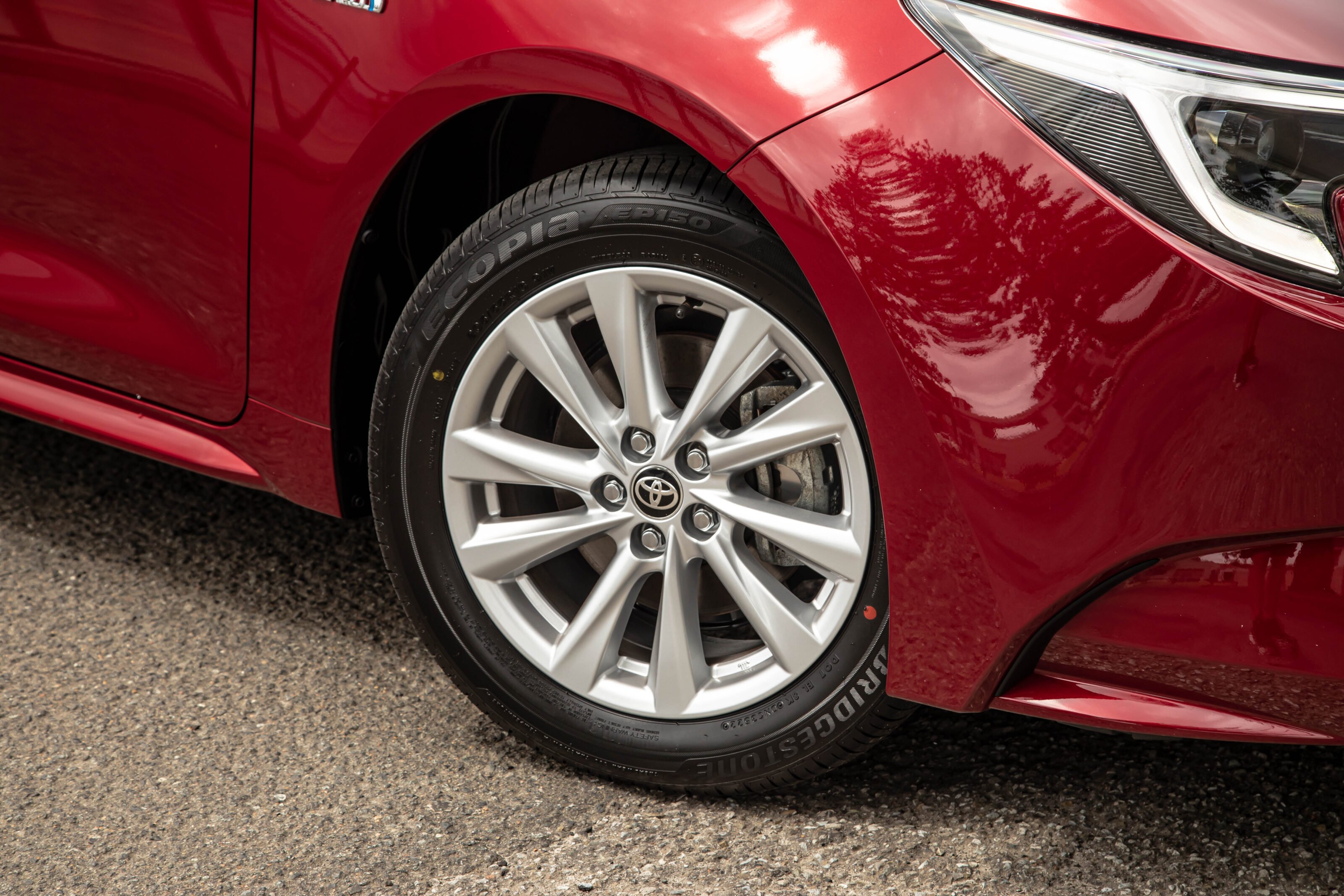
How is it on fuel?
The silly ADR test spat out a 3.9L/100km combined consumption figure to put on a sticker but in this case, it wasn’t so silly. In a week of varying use, our Corolla hybrid sedan returned an indicated 4.3L/100km.
| 2023 Toyota Corolla Ascent Sport hybrid sedan fuel consumption | |
|---|---|
| Fuel economy (ADR combined cycle) | 3.9L/100km |
| Fuel economy (tested) | 4.3L/100km |
| Fuel capacity | 43 litres |
| Fuel type | 91 RON / E10 |
Some folks swear blind that the trip computer could be off by 20 per cent, but I think that’s probably a little brave because it turns out that I filled it and came away with the same 4.3L/100km calculation.
The fuel tank is only 43 litres but with these figures, it’s not a big drama.
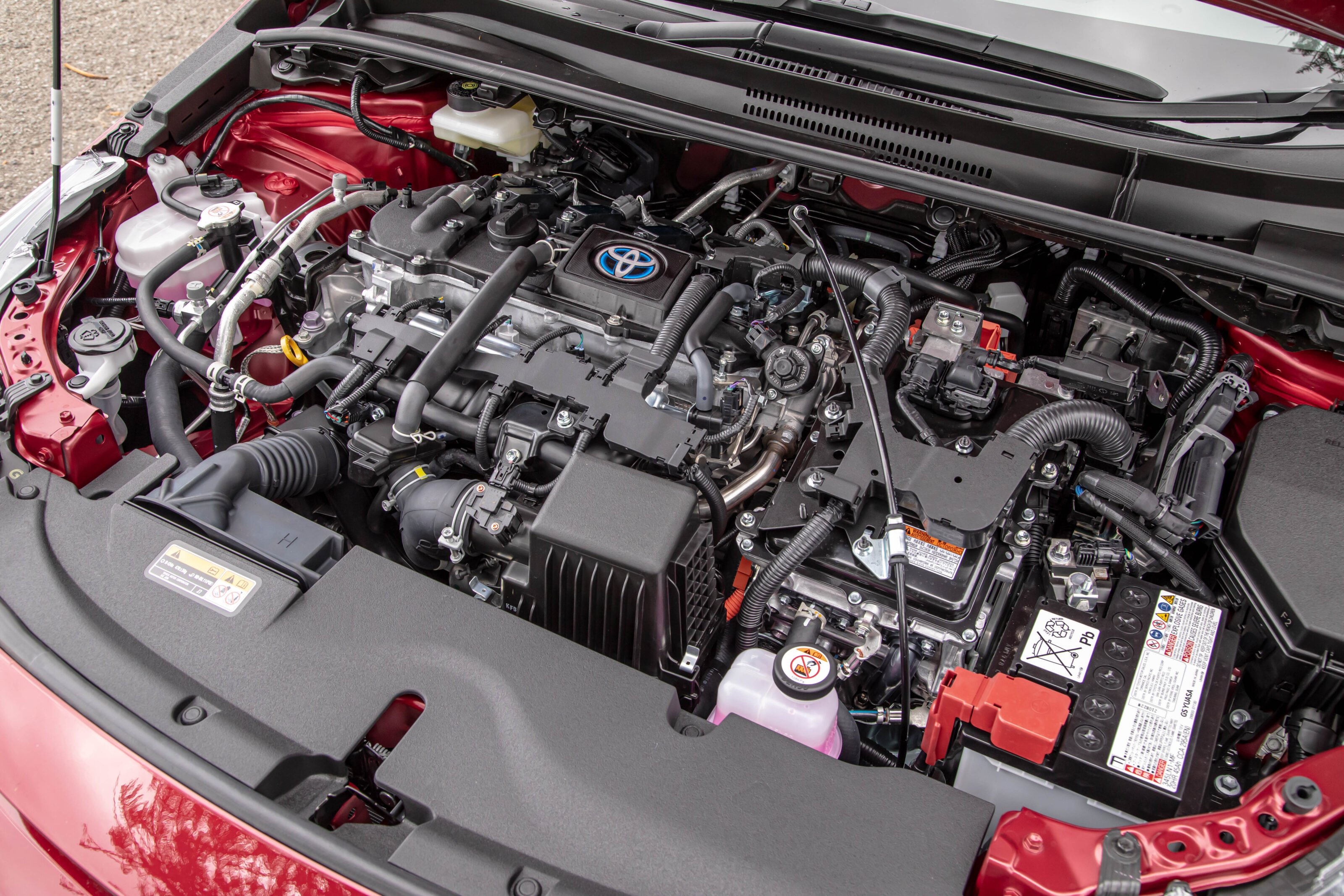
How safe is it?
The Corolla won its five-star ANCAP rating in 2018. The testing regime today may not see it hold on to that crown given the need for a centre-front airbag.
There is, however, a good list of features, such as my personal favourite, reverse cross-traffic alert.
| 2023 Toyota Corolla Ascent Sport hybrid sedan safety features | |
|---|---|
| 7 airbags (including driveru2019s knee) | Lane-keep assist |
| ABS | Reverse cross-traffic alert |
| Blind-spot monitoring | Reversing camera |
| Junction assist | Road sign recognition |
| Lane departure warning | Safe exit warning |
| Lane trace assist | Traction and stability controls |
| Forward auto emergency braking with pedestrian, motorcyclist and cyclist detection | |
The updated safety package includes more features in the auto emergency braking system, such as looking out for motorcyclists and helping to stop you from launching out across a junction if someone is coming your way.
For the kids, there are two sets of ISOFIX points and three top-tether anchors.
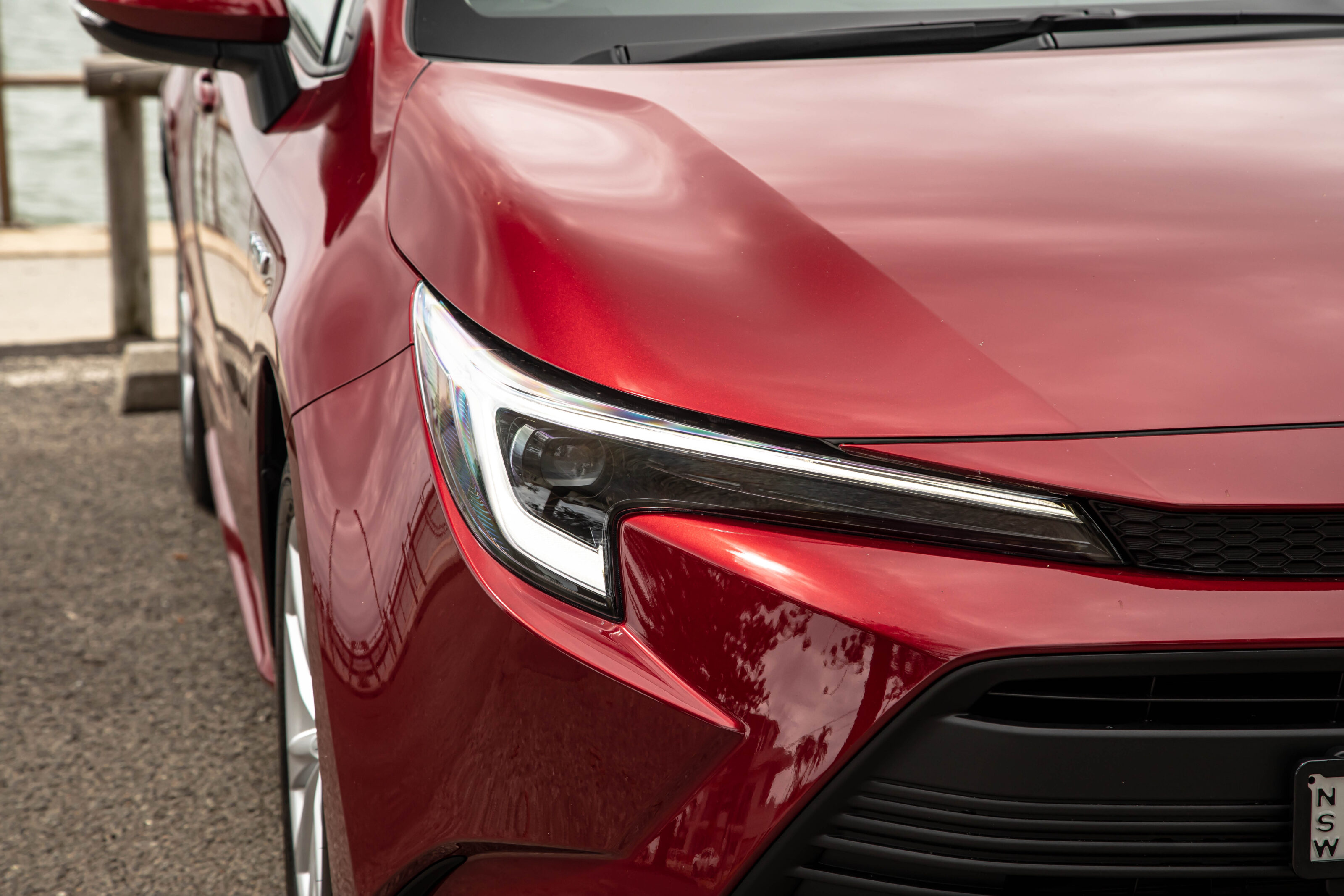
Warranty and running costs
Toyota’s five-year, unlimited-kilometre warranty applies to all Corollas.
And, as ever, you’d be mad not to service with Toyota because each of the first five services will cost $205 each for a total of $1025 over the five years.
It’s entirely likely that most if not all of these will be done in under 90 minutes so you can mooch around and play with your phone while they do it.
Service intervals are set at 12 months or 15,000km. A further two years of cover is on offer for the drivetrain if you keep servicing it with Toyota after the regular warranty expires.
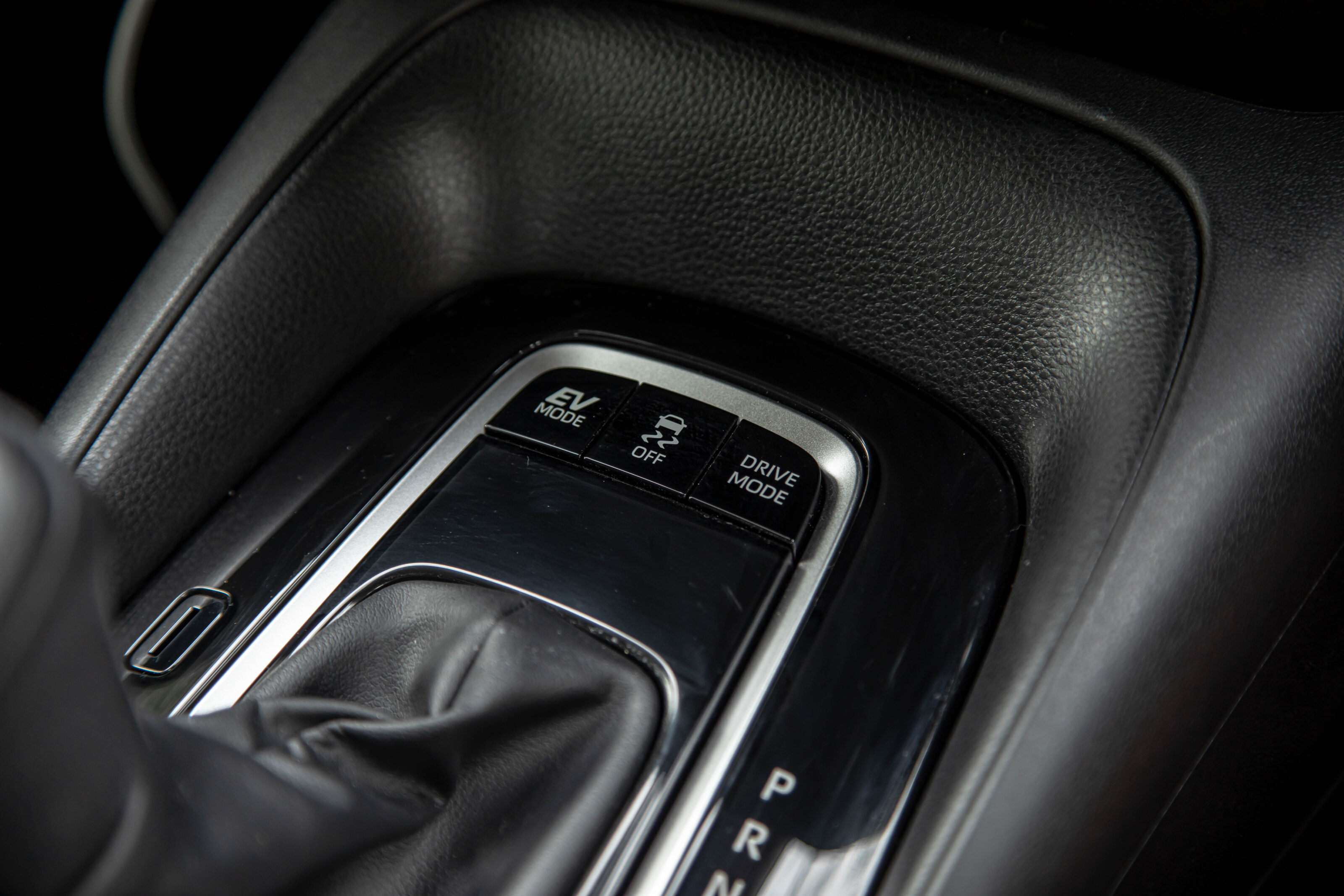
VERDICT
The Corolla hybrid sedan is not particularly stylish, roomy, cutting-edge or exciting, least of all in base Ascent Sport trim. The hatch isn’t hugely exciting either, but it does look a bit sportier and drives better than ever.
Regard the sedan as more of a load hauler and the real keys here are the improved media system and boosted hybrid set-up. The two of them deliver a more appealing package and despite a fairly basic cabin, it’s a pretty comfortable ride, even for long journeys.
You probably won’t buy a Corolla sedan for any other reason than it ticks the financial box, but with low running costs, a good warranty and lots of other sensible things, it’s definitely one where the head will win.
RELATED READING
Looking for more details on the wider Corolla range? Our full range review has everything you need to know.
| 2023 Toyota Corolla Ascent Sport hybrid sedan specifications | |
|---|---|
| Body | steel, four-door, four-seat small sedan |
| Drive | front-wheel |
| Engine | 1.8-litre four-cylinder hybrid |
| Transmission | continuously variable |
| Power (ICE) | 72kW @ 5200rpm |
| Torque (ICE) | 142Nm @ 3600rpm |
| Power (EV) | 70kW |
| Torque (EV) | 185Nm |
| Combined power | 103kW |
| Combined torque | not specified |
| Bore stroke (mm) | 80.5 x 88.3 |
| Compression ratio | 13.0 : 1.0 |
| 0-100km/h | 10 sec (estimate) |
| Fuel consumption | 3.9L/100km (combined) |
| Weight | 1430kg |
| Suspension | MacPherson struts front/double wishbone rear |
| L/W/H | 4630mm/1780mm/1435mm |
| Wheelbase | 2700mm |
| Brakes | 274mm ventilated disc front / 231mm solid disc rear |
| Tyres | 205/55 R16 |
| Wheels | 16-inch alloy, no spare |
| Price | $31,680 + on-road costs |
Score breakdown
Things we like
- Brilliant fuel economy
- Improved hybrid powertrain
- New screen
Not so much
- Plastic steering wheel
- Cheap tyres
- A bit boring to look at
We recommend
-
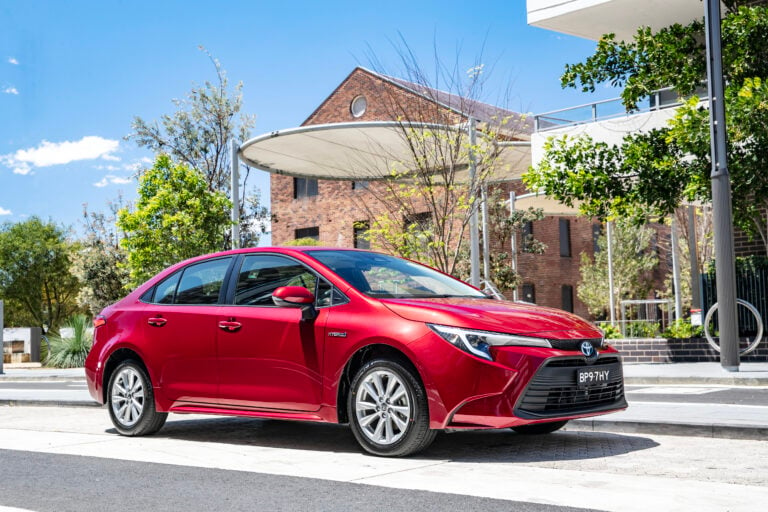 News
News2023 Toyota Corolla pricing and features
The refreshed 2023 Toyota Corolla range has been priced for Australia starting at $28,130 before on-road costs
-
 Reviews
Reviews2020 Toyota Corolla Hybrid sedan review
Venerable Corolla four-door gains petrol-electric tech for the first time
-
 News
NewsNew car calendar 2026: All the new cars coming to Australia next year
Here’s the WhichCar by Wheels guide to all the new cars that will launch in Australia in 2026. Check back in regularly for updates...


